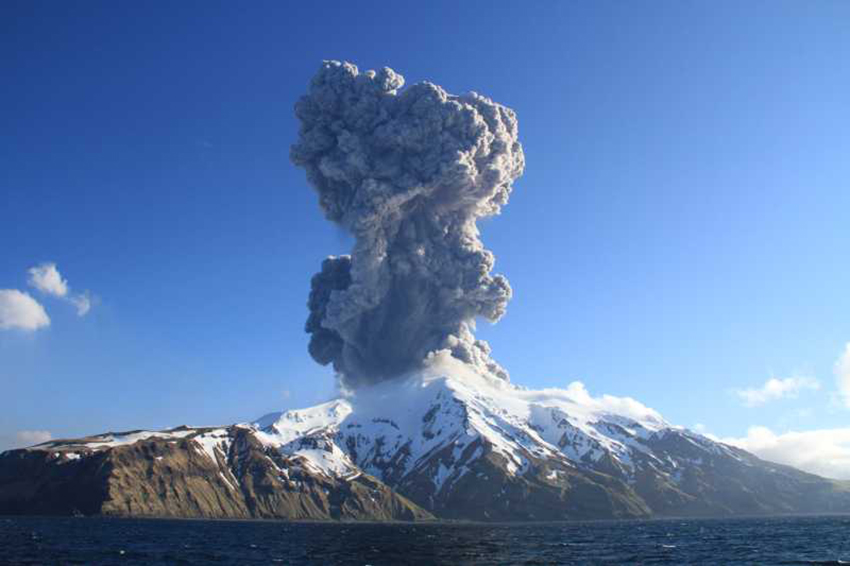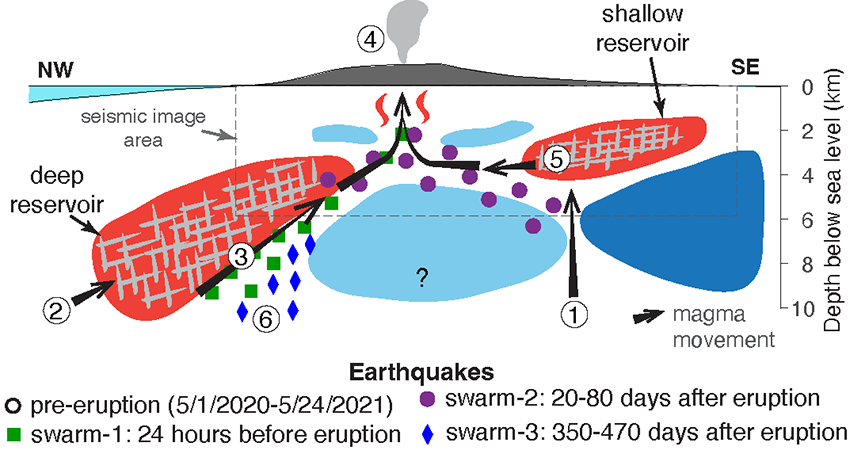New research explains what drives Alaska’s enduring and explosive Great Sitkin Volcano
06-08-2023

Study reveals long-lived volcanic eruption is powered by not one but two magma chambers tapping one another and an extra stage of eruption
One of Alaska’s most active volcanoes has been erupting since May 2021, but the location of intense seismic activity has moved around during that time. Scientists have wondered why, and now, new belowground imaging reveals the volcano actually has two magma chambers, which have driven the ever-shifting eruption.
Much like a tree, what you see above ground with volcanoes can pale in comparison to what is happening beneath the Earth’s surface. All of the magma and activity is building up below the surface and scientists use seismic data to measure this activity in hopes of learning more about the mechanics of a volcano and attempting to predict their behavior. An active volcano can put on a fiery show or spread ash around the globe.
These eruptions can cause regional chaos, but also upset weather patterns on a global scale. They can be societally disastrous, according to Dr. Xiaotao Yang, Assistant Professor of Purdue University’s Department of Earth, Atmospheric, and Planetary Sciences (EAPS). He studies seismology, tectonics and earthquake hazards.
Yang and a team of researchers have studied the seismic data from the Great Sitkin Volcano in Alaska’s Aleutian Arc, which has been erupting since May 26, 2021 (Coordinated Universal Time) with ongoing lava effusion since late July 2021. The team recently published their findings “Double Reservoirs Imaged Below Great Sitkin Volcano, Alaska, Explain the Migration of Volcanic Seismicity” in the American Geophysical Union’s Geophysical Research Letters.
At the Great Sitkin Volcano, seismic activity (earthquakes) before and during the current eruption alternated between regions to the northwest and the southeast of the volcano summit, within a northwest-southeast trending seismic zone across the island. Yang and his colleagues wanted to pinpoint the cause of this spatial variability, which can make warning for earthquakes and volcanic hazards difficult.
The team constructed a seismic velocity structure for the uppermost 6 kilometers of the Great Sitkin Volcano, collecting data with seismic data from 2019 to 2020 (more than a year before the eruption began) collected by the Alaska Volcano Observatory.
This paper investigates how these volcanic eruptions develop with time and what controls them. The team addressed these issues by constructing the seismic velocity structure of the top 6 km below Great Sitkin Volcano in the central Aleutian arc. The findings in this study help to better understand the control of eruption behaviors by the underlying magma plumbing system at active volcanoes. This will help the prediction of volcanic eruptions and the assessment of volcanic hazards.
The team consists of Yang and Cody Kupres, MS student, of Purdue University, Diana C. Roman of Earth and Planets Laboratory at Carnegie Institution for Science, and Matt Haney of the Alaska Volcano Observatory, U.S. Geological Survey. Yang conducted seismic imaging to get the subsurface seismic model of the Great Sitkin Volcano and led the formal analysis of the earthquake catalog and seismic velocity model. Kupres contributed to the selection of the study site and helped interpret the seismicity and seismic velocity model.
The team proposes that Great Sitkin Volcano has not one but two magma reservoirs bubbling deep beneath the Earth’s surface and has a six-stage eruption cycle. Typically, the magmatic system undergoes five stages: magma accumulation, increased seismic activity, initial eruption (could be explosive or effusive), continuing eruptions with a lava fountain or flow, and decaying activity as the eruption reaches the end. The team proposes though that the Great Sitkin Volcano actually has an additional stage with the second (shallower) magma chamber kicked in following the initial eruption likely sourced from the deeper chamber. This is an important addition as it implies the interaction between the chambers that both contribute to the lava effusion. Tapping of magma chambers has been proposed at other places. Together, this six-stage eruption cycle and the dual-magma chambers explain the evolution of seismicity in space and time across the island and the alternating eruption of two reservoirs.
“This phenomenon of changing earthquake locations with time, termed spatiotemporal migration, has also been observed at other volcanoes. However, vertical migration of volcanic seismicity is more common,” says Yang. “The clear lateral migration of seismicity below Great Sitkin volcano provides an important opportunity to study the control of eruption seismicity and what it tells us about the development of volcanic eruptions. The new seismic velocity model reveals two crustal magma reservoirs, with distinctly low seismic velocities (the speed of a seismic wave traveling through the medium).”

Above: The earthquakes that happened before and during the eruption are primarily concentrated along the edge of magma reservoirs as pictured above. The observation of a double-reservoir magmatic system correlating with the two seismically active regions to the northwest and southeast of the volcano summit suggests that the two reservoirs interreacted with each other with alternating magmatic activities.
Below: Typically, the magmatic system undergoes five stages: magma accumulation, increased seismic activity, initial eruption (could be explosive or effusive), continuing eruptions with a lava fountain or flow, and decaying activity as the eruption reaches the end. But with the Great Sitkin Volcano, the research team proposed an additional stage involving the eruption sourced from the second, shallower reservoir. Graphics provided by Yang.

The team attributed additional observations of the eruption to the presence of dual magma chambers. First, the seismicity at the volcano (before and during the eruption) shows a clear lateral migration at different times. Also, the reservoir to the southeast reached its peak seismicity level one year before the eruption on May 26, 2021, though the initial eruption was companioned by an increased seismicity level only to the northwest of the summit. They also observed that the initial eruption was explosive, though only negligible magma erupted. The peak lava effusion started about two months after the initial eruption, which left a two-month gap between the initial eruption and lava effusion. This phase of lava effusion coincided with the ramping seismicity to the southeast. About a year after the initial eruption, there was a second phase of lava effusion that is consistent with increased seismicity to the northwest.
“These observations suggest alternating volcanic activity between the two magma reservoirs, which is an important addition we propose compared to the typical stages based mostly on a single-reservoir model or a model involving mostly vertical migration of seismicity,” says Yang. “However, we argue that the phenomenon we observe at Great Sitkin Volcano is not unique to this volcano. It can be generalized to help us understand how multiple reservoirs, which may be in different sizes, could interact and influence the initialization and development of the eruption as well as magma flux.”
The unpredictable nature of volcanic activity can release lava, ash, water, and gases into the atmosphere quickly or slowly over time. Yang says that using seismic data alone is not enough for a thorough investigation. Scientists need to monitor gas emissions, surface deformation, temperature changes and other data. Each volcano requires thorough research so that scientists can better predict how and when volcanoes might erupt in the future.
“Our work at Great Sitkin Volcano demonstrates the complexity of active magmatic systems and the importance of real-time monitoring of active volcanoes, including earthquake activities, gas emissions, surface deformation, and surface temperature, building on top of the knowledge on the distribution of active magma reservoirs,” says Yang.
About the Department of Earth, Atmospheric, and Planetary Sciences at Purdue University
The Department of Earth, Atmospheric, and Planetary Sciences (EAPS) combines four of Purdue’s most interdisciplinary programs: Geology & Geophysics, Environmental Sciences, Atmospheric Sciences, and Planetary Sciences. EAPS conducts world-class research, educates undergraduate and graduate students, and provides our college, university, state and country with the information necessary to understand the world and universe around us. Our research is globally recognized, our students are highly valued by graduate schools, employers, and our alumni continue to make significant contributions in academia, industry, and federal and state government.
About Purdue University
Purdue University is a top public research institution developing practical solutions to today’s toughest challenges. Ranked in each of the last five years as one of the 10 Most Innovative universities in the United States by U.S. News & World Report, Purdue delivers world-changing research and out-of-this-world discovery. Committed to hands-on and online, real-world learning, Purdue offers a transformative education to all. Committed to affordability and accessibility, Purdue has frozen tuition and most fees at 2012-13 levels, enabling more students than ever to graduate debt-free. See how Purdue never stops in the persistent pursuit of the next giant leap at https://stories.purdue.edu.
Writer: Cheryl Pierce, Communications Specialist
Contributor: Dr. Xiaotao Yang, Assistant Professor of Purdue University’s Department of Earth, Atmospheric, and Planetary Sciences